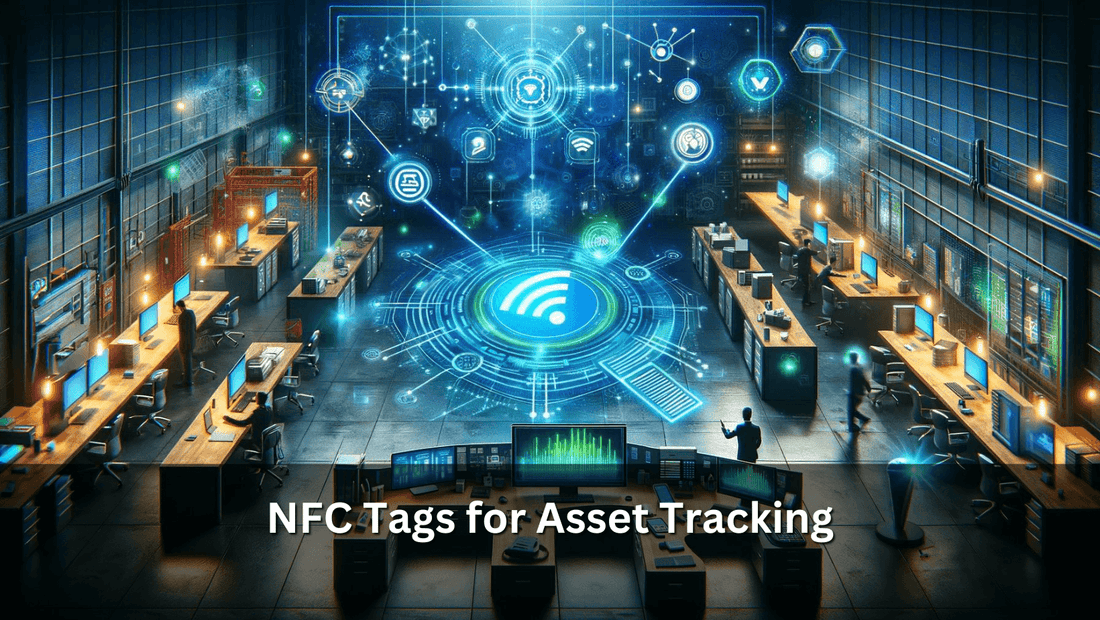The Asset Game-Changer

5 Reasons Why Contactless NFC is the Best Solution for Asset & Inventory Tracking
Overview of NFC in Asset Tracking
NFC (Near Field Communication) technology stands as a transformative tool in the realm of asset and inventory management. At its core, NFC facilitates short-range communication between compatible devices or a device and an NFC tag, embedded within assets or inventory items. This technology enables businesses to track and manage assets with unparalleled ease and precision.
One of the primary advantages of NFC in asset tracking is its contactless nature, which allows for quick scanning without the need for direct line-of-sight or physical contact. This is particularly beneficial in fast-paced environments where speed and efficiency are paramount. Moreover, NFC tags can store a wealth of information—from basic identification data to detailed asset history—accessible with a simple tap using an NFC-enabled device.
The adoption of NFC technology in asset management not only streamlines inventory processes but also enhances data accuracy and reduces the likelihood of errors. As businesses continue to seek more efficient ways to manage their assets, NFC stands out as a reliable, scalable, and cost-effective solution, heralding a new era in asset and inventory tracking.
NFC vs. Other Tagging Technologies
NFC technology offers distinct advantages over traditional tagging methods like RFID, barcodes, and QR codes, particularly in asset tracking applications. While RFID shares similarities with NFC in wireless data transmission, NFC operates at closer ranges, enhancing security and reducing unintended scans. This proximity requirement makes NFC ideal for secure transactions and precise asset management, where control over what is being scanned is crucial.
Barcodes and QR codes, on the other hand, require optical scanning and direct line-of-sight, which can be cumbersome in environments with difficult-to-reach items. NFC tags eliminate this challenge by allowing scans through touch or close proximity, streamlining the inventory process, especially in cluttered or space-constrained settings.
Moreover, NFC's capacity for two-way communication enables not just asset tracking but also the update and manipulation of the data on the tag itself, offering dynamic interaction that barcodes and QR codes lack. This feature is particularly beneficial for real-time inventory management and asset maintenance records, providing a more flexible and interactive solution for businesses. In summary, NFC's unique blend of security, convenience, and interactive capabilities positions it as a superior choice for modern asset tracking needs. For further insight into the standards that enable these technologies to work seamlessly together, visit GS1 US.
Advantages of NFC Tags for Asset Management
The integration of NFC (Near Field Communication) technology into asset management systems presents a myriad of benefits, making it an attractive option for businesses seeking efficiency, security, and cost-effectiveness. Below are five significant advantages of employing NFC tags for asset management. For a deeper dive into how NFC technology is shaping asset management and to explore detailed case studies, RFID Journal offers a wealth of information and resources that underscore the transformative impact of NFC in various industries.
-
Convenience
NFC technology simplifies asset tracking with its user-friendly approach. Unlike traditional methods that may require cumbersome scanning devices and direct visibility, NFC tags can be scanned quickly and easily using smartphones or other NFC-enabled devices. This convenience allows for seamless inventory audits, asset location tracking, and on-the-go data retrieval, significantly reducing the time and effort involved in asset management tasks. The ability to scan multiple items closely or through obstacles like packaging materials further enhances operational efficiency.
-
Security
NFC offers superior security features compared to other tagging technologies. Each NFC tag can be encrypted and locked, preventing unauthorized access to the stored information. This level of security is paramount in industries where sensitive data protection is crucial. Additionally, NFC's short-range communication minimizes the risk of interception, making it a safer choice for secure transactions and data exchanges. The technology also supports dynamic authentication, which can further safeguard against tampering and unauthorized data retrieval.
-
Minimal Training for Staff
The intuitive nature of NFC technology eases the training process for employees. Most people are familiar with using smartphones and similar devices, which are the primary tools for scanning NFC tags. This familiarity reduces the learning curve significantly, allowing staff to adapt quickly without extensive training sessions. The straightforward process of tapping a device to an NFC tag to retrieve or update information means that employees can become proficient in its use rapidly, ensuring a smooth transition to the new system.
-
Fast Processing
NFC's ability to facilitate instant data transfer accelerates the processing times for inventory and asset management tasks. Information from NFC tags is retrieved the moment a device comes into close proximity, allowing for real-time updates and access to asset data. This immediate processing capability ensures that inventory records are always current, reducing the likelihood of errors or discrepancies that can occur with slower, manual input methods. Fast processing also supports better decision-making, as managers have access to the most up-to-date information.
-
Low Running Costs
Implementing NFC technology can be cost-effective compared to traditional asset tracking systems. NFC tags are relatively inexpensive and durable, capable of withstanding harsh environments, which reduces the need for frequent replacements. The use of smartphones or existing NFC-enabled devices for scanning eliminates the need for specialized scanning equipment, further lowering initial investment and maintenance costs. Additionally, the efficiency and speed of NFC can lead to operational cost savings by reducing the time spent on asset management tasks.
In summary, NFC technology offers significant advantages for asset management, including convenience, enhanced security, minimal training requirements, fast processing, and low running costs. These benefits combine to make NFC an ideal solution for businesses looking to optimize their asset tracking and inventory management practices.
Implementing NFC Technology: Key Considerations
Implementing NFC technology for asset tracking involves careful planning and consideration to ensure a smooth integration and maximum efficiency. Firstly, assess your current asset management system and determine how NFC can complement or enhance it. Select NFC tags that are durable and suitable for the assets you're tracking, considering factors such as memory capacity, read range, and environmental resistance.
Integration with existing software systems is crucial. Ensure that the NFC technology you choose can seamlessly communicate with your inventory management or ERP system. This may require middleware or custom development to bridge the gap between NFC data and your system's database.
Staff training is another critical component. While NFC is user-friendly, ensuring that all relevant employees understand how to use the technology effectively is essential. Focus on practical training sessions that include hands-on exercises with NFC tags and readers. Highlight the benefits of NFC to encourage adoption and demonstrate how it can make their tasks easier and more efficient.
Lastly, consider future scalability. Choose an NFC solution that can grow with your business, allowing for the addition of more tags and the expansion of NFC functionality into other areas of operations.
Conclusion: Embracing NFC for Future-Proof Asset Management
Embracing NFC technology signifies a forward-thinking approach to asset and inventory management. Its potential to revolutionize tracking systems lies in its adaptability, efficiency, and the myriad benefits it offers. NFC enables businesses to streamline operations, enhance security, and reduce costs, all while maintaining a high degree of accuracy and reliability in asset tracking. As companies continue to navigate the complexities of modern inventory management, NFC stands out as a robust solution that can adapt to future challenges and technological advancements. Investing in NFC technology is not just about improving current operations—it's about future-proofing your asset management strategy, ensuring resilience and competitiveness in the rapidly evolving business landscape.









